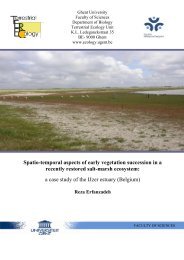PhD Arthur Decae 2010 - Ghent Ecology - Universiteit Gent
PhD Arthur Decae 2010 - Ghent Ecology - Universiteit Gent
PhD Arthur Decae 2010 - Ghent Ecology - Universiteit Gent
You also want an ePaper? Increase the reach of your titles
YUMPU automatically turns print PDFs into web optimized ePapers that Google loves.
Island endemics: Of the 49 "Mediterranean" species and subspecies listed in Platnick 2003<br />
twelve species (24%) are known exclusively from islands, and only two (N. cellicola and N.<br />
maculatipes) species (4%) are recorded from both mainland and island locations 15 .<br />
Widespread island endemism is also supported by records, partly as yet unpublished, of<br />
endemic Nemesia species from Crete, Corfu, Malta, Sicily, Sardinia, Corsica, Elba,<br />
Montecristo, Ile d' Alboran, Majorca and Ibiza.<br />
Mainland endemics: Local endemism is also found in continental areas. In southern France,<br />
where Nemesia was first studied in some detail, Moggridge 1873, 1874 discovered that the<br />
Nemesia faunas east and west of the river Rhone differed remarkably in their species<br />
composition. East of the Rhone he found N. carminans, N. congener O.P-Cambridge 1874, N.<br />
e/eanora O.P-Cambridge 1873 and N. manderstjernae 16 , while west of the Rhone he found N.<br />
caementaria (Latreille 1799), N. dubia O.P-Cambridge 1874 and N. simoni. Simon 1914<br />
added N. raripila from the Pyrenees to the Nemesia fauna of southwest France. In a current<br />
study of the Nemesia fauna of Portugal (<strong>Decae</strong> & Cardoso in prep.) endemism again seems to<br />
be a remarkable feature, because none of the six species collected from various sites<br />
throughout Portugal has so far been found in Spain. Since some of the Portuguese collections<br />
were made close to the Spanish border, it is unlikely that all these species are absent from<br />
Spain, but their presence there still has to be established. This study of the Portuguese<br />
Nemesia fauna also shows that the presence of species that had previously been reported from<br />
Portugal, but that have their type localities in distant lands (N. dubia from Montpellier, N.<br />
meridionalis Costa, 1835 from Naples), could not be reconfirmed, which suggests that the<br />
distribution of these species is more restricted than previously supposed. The information<br />
presented here on the species of Majorca and Ibiza also underlines the view that local<br />
endemism is strong in Nemesia, because the Nemesia fauna of Majorca appears to differ from<br />
that of nearby Ibiza, and because it shows that even on an island the size of Majorca, species<br />
distributions can be geographically separate (see Fig. 84 for the distributions of N. bristowei<br />
and N. randa).<br />
Whether Nemesia really is a regional genus composed of numerous locally endemic species,<br />
however, requires further investigation. Too little is currently known about the identity of<br />
individual species in large parts of the distribution range (Spain, Italy, Balkans, Greece, North<br />
Africa) and virtually nothing is known about possible interspecific, let alone phylogenetic,<br />
relationships between species. Early suggestions of such relationships (Simon 1914; Frade &<br />
Bacelar 1931) were unavoidably speculative owing to the very limited amount of information<br />
then available.<br />
New collections and the discovery of better diagnostic characters (particularly spermathecae<br />
and spinneret morphology) have provided the opportunity for the following fresh speculations<br />
on possible interspecific relationships within Nemesia.<br />
Based on the morphology of the spermathecae, a broad division between eastern and western<br />
Nemesia species may exist. The eastern species characteristically have narrow, elongated<br />
spermathecae that are medially "twisted", as illustrated here for N. seldeni (Fig. 53). Western<br />
species have simpler built and much broader spermathecae as shown here in Figs. 19, 32, 39,<br />
15 There is some doubt about the correctness of distribution data for the two species reported from both mainland and island<br />
locations, first, because the reported distributions are not easily explained and show unlikely disjunctions, and secondly,<br />
because these two species, N cellicola (Audouin, 1826) and N. maculatipes Ausserer, 1871, are species that (for different<br />
reasons) are easily misidentified. N. cellicola is the type species of the genus, and in early collections, before information on<br />
the diversity of Nemesia was available, was reported mistakenly from various wide1y separated locations. Nemesia<br />
maculatipes seems to carry its diagnostic character in its name (the maculae on legs and PLS), but it is now clear that the<br />
maculate pattern is present in different, only distantly related, Nemesia species and that such species are easily confused.<br />
16 The distinction between the last two species is currently unclear.










